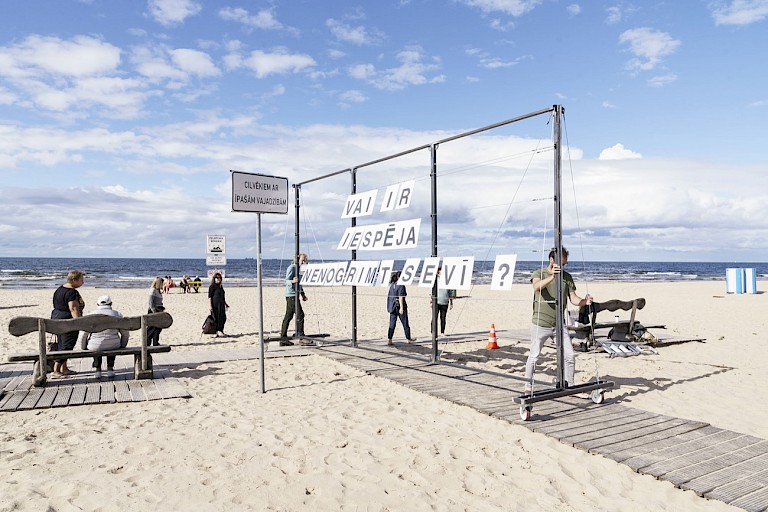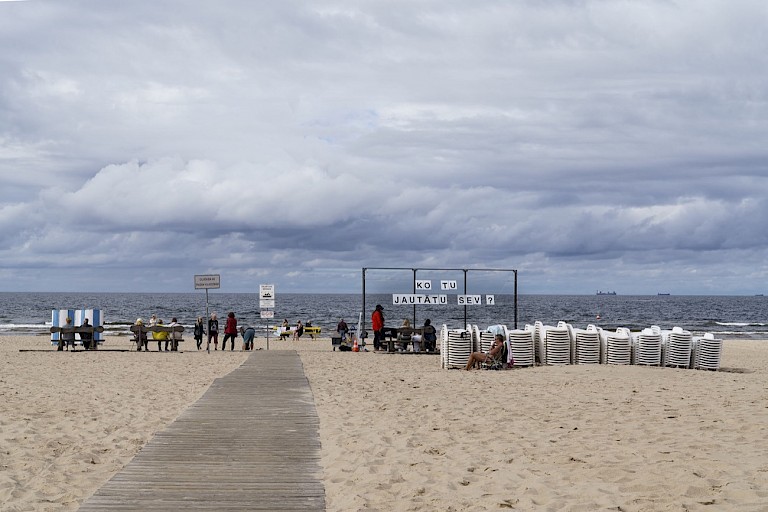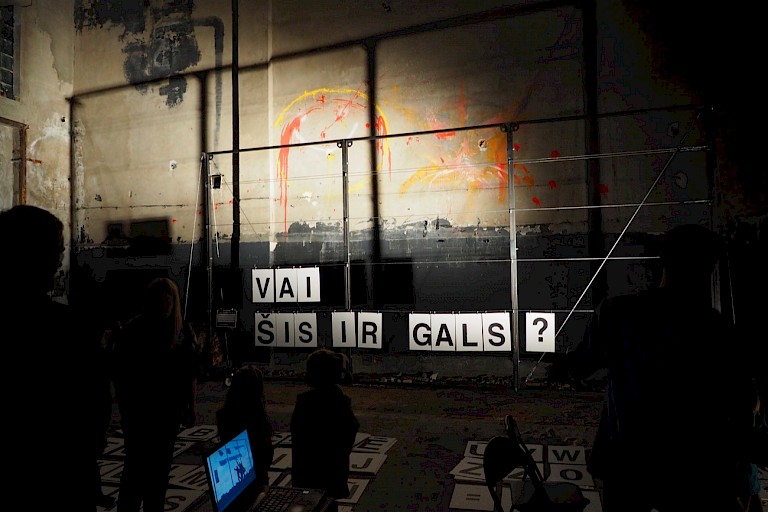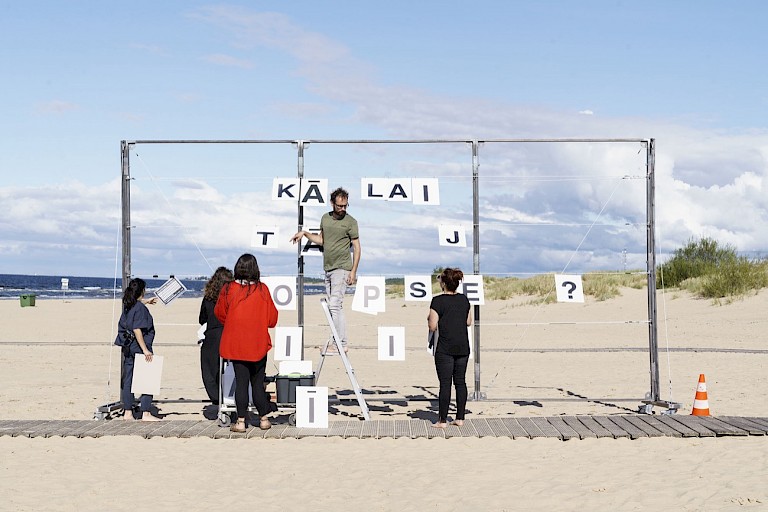



The Mil M2 collective, a group known for their innovative approach to public engagement, was extended an invitation by Gundega Laivina, the then-director of the Homo Novus festival in Riga, Lithuania. The collective’s unique methodology, which they had refined over several meetings prior to their trip, hinges on establishing a meaningful connection with the local community. This approach has proven effective in various locations where the collective’s Project Question has been implemented.
An integral part of their methodology involves assembling an activation team in each location they visit. This team, composed of locals, assists the collective in their street work. The need for such a team arises from language barriers and the context-specific nature of the questions that emerge during the project. As outsiders, the members of the collective understand that their relationship with the context, and consequently, the questions that arise, will be interpreted differently compared to the locals. The activation team provides this crucial spatial, social, and political context and are considered collaborators of the project.
The questions that emerge from this process are deeply rooted in the community and its social context, thereby also taking on a spatial dimension. For instance, a question posed in a public square carries a different weight and implication than if it were asked outside a hospital or at the city’s limits.
In 2020, for their project in Riga, Mil M2 collaborated with four individuals and a local producer. This producer, Bek Berger, later assumed the role of Festival Director, succeeding Gundega Laivina. The local collaborators included two architects, a public space artist, and a woman with a background in translation who worked at one of Riga’s most popular bars. This diverse group not only expanded the network of participants but also facilitated rich dialogues.
Their varied backgrounds also influenced the selection of locations for the project. Despite the ongoing COVID-19 health crisis, they chose iconic places with high visitor traffic such as markets, squares, the Freedom Monument, downtown areas, and even beaches.
The project spanned two weeks during the festival. The first week was dedicated to understanding the context, visiting potential locations, and familiarizing themselves with the city. In the second week, they activated their mobile device using four guiding questions chosen specifically for Riga.
These questions were: “What would you ask Riga?”, “What would you ask the future?”, and “What would you ask yourself?”. Each guiding question was crafted to stimulate thought and foster participant engagement. During the festival, hundreds of questions were gathered and subsequently assembled into a fanzine designed by the collective.
They also hosted a kind of opening reception in a studio space where they were able to showcase videos of their previous iterations of the Question Project. An archive featuring the 150 questions collected in Riga during the Festival was on display, and a multilingual fanzine was available for attendees to take home."
The Question Project excellency is linked to its ability to adapt to particular contexts and the capacity to ask questions about humanity in general. That is the main reason why it has taken multiple forms, most of them in the form of actions in the public space, but also in museums, as well as in the production of printed material.
For that reason, the Question Project serves as a rich case study for academic research in fields like community engagement, public art, and social innovation. It offers insights into how art can be used as a tool for social dialogue and community building. The project’s approach has the potential to inspire similar initiatives worldwide. Its success in engaging communities could serve as a model for artists and organisations globally.
The Question Project encourages people to think critically about their surroundings and societal issues, involving the public in the creation of art and making art more accessible and relatable to everyday life.
The project’s implementation at the Homo Novus Festival in Riga, Latvia is a testament to its adaptability. Amidst a city dealing with political tensions, the project sparked critical reflections and led to a series of interventions throughout the city. Each activation fostered collective questioning of social issues, seeking to open new types of community awareness and civic engagement.
It operates in both public and private spaces, requiring human operation and interaction. The project also serves as an archive of questions in dialogue with various fields. Despite its exploration of questions, it seeks no answers but revels in the process of questioning.
MilM2 has performed the Question Project in several cities around the world and they now have an immense archive of questions that reflect the differences and particularities of humankind in this particular time in history. Some of the cities that have hosted the Question Project are: Dublin, Berlin, Dresden, Punta Arenas, Quito and Santiago de Chile. The Question Project has also been part of specific discussions commissioned by specific institutions. One example of that is the one by Elige Educar in Chile, a prominent organisation in the field of education, that has initiated a collaborative workspace that is dedicated to research and cooperation with civil society organisations. This initiative is aimed at transforming public policies that have been deeply rooted since the era of military dictatorship. This collaborative workspace serves as a platform for these organisations to come together, share their insights, and work towards a common goal. As a participatory instance of the program, the methodology of the Question Project was compiled into a Toolkit. A total of 100 copies of this Toolkit were distributed across various schools throughout the country. The aim was to stimulate discussion and disseminate questions that would activate debates and proposals from different positions and territories using methods and approaches to involve citizens in decision-making processes, community planning, or policy development.
MILM2 is a collective that activates critical reflection through various interventions in public spaces and the boundaries between common and private realms. Their approach involves experimentation, from the performativity of bodies and their social organisations to the creation of relational artisanal objects. They aim to foster dialogue, knowledge tools, systems for togetherness, methodologies of sensitivity, community spaces, and aesthetic experiences.
Their journey began in Santiago, Chile in 2013 with the development of self-managed spaces. They established the community center ""Mil M2"", and after its demolition, they developed the site-specific space ""Proyecto Pendiente"" and the craft construction lab ""Mil M2"". These initiatives gave birth to various projects like Proyecto Pregunta (Question project), Construir una Biblioteca (Building a library), Campo de Juego (Playing field), and Imprenta Ciudadana (Citizen Printing House).
Since 2017, they have been working nomadically, engaging with spaces across South America, the Caribbean, and Europe. Amidst the ongoing political, social, economic, health, and environmental crises of 2020, they continue to explore new ways to stimulate collective critical reflections.
The collective members are Constanza Carvajal, Diego Cortés, Cote Jaña, Cecilia Moya Rivera, Fernando Portal, and Pedro Sepúlveda Cruz Coke.
*Mil M2 is Spanish for one thousand square meters.



